Econ Midtern #2
1/69
Earn XP
Description and Tags
goo goo gah gah
Name | Mastery | Learn | Test | Matching | Spaced |
|---|
No study sessions yet.
70 Terms
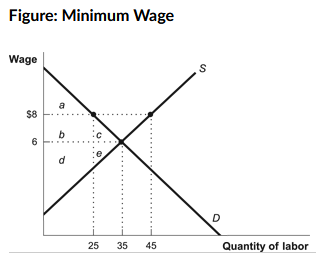
(Figure: Minimum Wage) Refer to the figure. How many workers are unemployed at a minimum wage of $8?
a. 10
b. 20
c. 25
d. 35
b. 20
The U.S. Congress first instituted the minimum wage in:
a. 1914
b. 1974
c. 1938
d. 1925
c. 1938
A price floor is:
a. a maximum price allowed by law.
b. a minimum price allowed by law.
c. able to produce an efficient outcome.
d. a tool used to increase government revenues.
b. a minimum price allowed by law.
Flexible prices ensure that:
a. resources are allocated to their highest-valued uses.
b. suppliers will always profit from necessity goods.
c. self-interested individuals will not interfere with the efficiency of the market.
d. prices will always be minimized.
a. resources are allocated to their highest-valued uses.
A price ceiling is a(n):
a. legally established minimum price that can be charged for a good.
b. illegally established minimum price that can be charged for a good.
c. legally established maximum price that can be charged for a good.
d. illegally established maximum price that can be charged for a good.
c. legally established maximum price that ca be charged for a good.
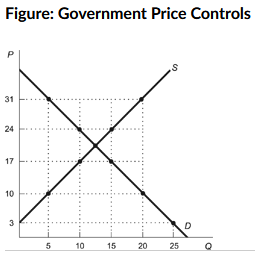
(Figure: Government Price Controls) Refer to the figure. The government enacts a price control causing a shortage of 15 units of the good. Therefore, the ________ is set at ________.
a. price floor; $31
b. price floor; $17
c. price ceiling; $10
d. price ceiling; $17
c. price ceiling; $10
(Figure: Price Ceiling) Refer to the figure. When a price ceiling of $10 is instituted by the government, consumers are able to buy how many units of the product?
a. 290 units
b. 310 units
c. 270 units
d. 40 units
c. 270 units
Do price ceilings misallocate resources?
a. Yes, because people who value the good the most are unable to bid it away from low-valued uses.
b. Yes, because people who value the good the least are unable to afford the good.
c. No, because the good is still allocated based on willingness to pay.
d. No, because the rich and poor alike stand an equal chance of getting the good.
a. Yes, because people who value the good the most are unable to bid it away from low-valued uses.
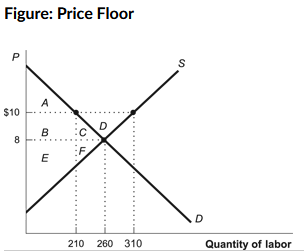
(Figure: Price Floor) Refer to the figure. What are the lost gains from trade as a result of the imposition of the price floor?
a. Areas (B + C)
b. Area D
c. Areas (C + F)
d. Areas (B + E)
c. Areas (C + F)
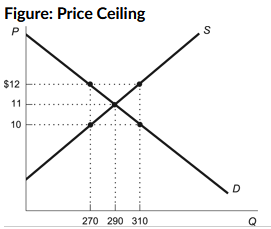
(Figure: Price Ceiling) Refer to the figure. A price ceiling of $10 results in a:
a. shortage of 270 units.
b. shortage of 40 units.
c. surplus of 270 units.
d. surplus of 40 units.
b. shortage of 40 units.
Economic policies of protectionism include:
I. reduced trade barriers.
II. tariffs.
III. quotas.
a. I and II only
b. II and III only
c. I and III only
d. I, II, and III
b. II and III only
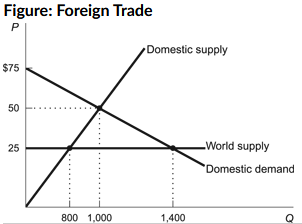
(Figure: Foreign Trade) Refer tot he figure, What quantity would be produced domestically?
a. 600
b. 1400
c. 1000
d. 800
d. 800
A tariff is:
a. the restriction of trade through regulations on domestic producers.
b. a restriction on the quantity of goods that can be imported.
c. equal to exports minus imports.
d. a tax on imports.
d. a tax on imports.
A trade quota is:
a. a restriction on the quantity of goods that can be imported.
b. a tax on imports.
c. a tax on exports.
d. the restriction of trade through regulations on domestic producers.
a. a restriction on the quantity of goods that can be imported.
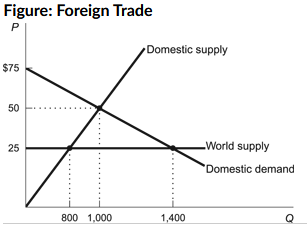
(Figure: Foreign Trade) Refer to the figure. What quantity would be traded in a free-trade environment?
a. 600
b. 1400
c. 1000
d. 800
b. 1400
In post cases, trade restrictions will:
a. save jobs without any other costs.
b. save some jobs and destroy other jobs.
c. benefit both producers and consumers.
d. benefit only the government.
b. save some jobs and destroy other jobs.
A tariff ______ the world supply of a good.
a. reduces
b. increases
c. does not change
d. has no measurable effect on
a. reduces
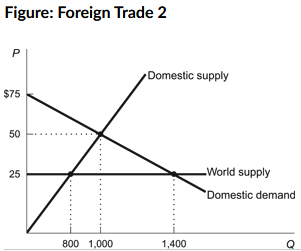
(Figure: Foreign Trade 2) Refer to the figure. What is the dollar value of wasted resources as a result of prohibiting trade in this market?
a. $30000
b. $5000
c. $2500
d. $22500
c. $2500

(Figure: Foreign Trade) Refer to the figure. What quantity would be imported?
a. 600
b. 1400
c. 1000
d. 800
a. 600
Who does protectionism hurt?
a. domestic producers only
b. domestic consumers only
c. international producers only
d. international producers and domestic consumers
d. international producers and domestic consumers
An external cost:
a. causes market to allocate resources efficiently.
b. affects producers but not consumers.
c. is a cost paid by people other than the producer or consumer trading in the market.
d. leads to economic efficiency only when private costs are greater than external costs.
c. is a cost paid by people other than the producer or consumer trading in the market.
What is the importance of the Clean Air Act of 1990?
a. Under this act, the EPA distributes pollution allowances to electricity producers.
b. Under this act, the EPA sets the maximum amount of pollution that each firm may emit.
c. The act lists the pollutants that are deemed harmful to the environment.
d. The act delineates which firms are allowed to emit more than 1 ton of sulfur.
a. Under this act, the EPA distributes pollution allowances to electricity producers.
Government solutions to externality problems include:
a. taxing the consumption of goods that cause externalities.
b. subsidies.
c. allowing firms to trade the rights to create pollutants.
d. All of the answers are correct.
d. All of the answers are correct.
A viable government solution to an external cost is a":
a. tax on the party producing the cost.
b. subsidy to the party producing the cost.
c. tax on the party incurring the cost.
d. subsidy to the party incurring the cost.
a. tax on the party producing the cost.
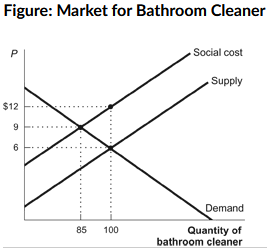
(Figure: Market for Bathroom Cleaner) Refer to the figure. The figure shows a market for cans of a bathroom cleaner that causes environmental damage, imposing costs on people other than the consumers and producers of the cleaner. What is the efficient quantity in this market?
a. 100
b. 85
c. 15
d. 9
b. 85
A Pigouvian tax:
a. is levied on a good that creates a negative externality and should be set equal to the external cost to eliminate the deadweight loss.
b. subsidizes a good that creates a negative externality and should be set equal to the external cost to eliminate the deadweight loss.
c. is levied on a good that creates a positive externality and should be set equal to the external benefit to eliminate the deadweight loss.
d. is levied on a good that creates a positive externality and should be set equal to the social benefit to eliminate the deadweight loss.
a. is levied on a good that creates a negative externality and should be set equal to the external cost to eliminate the deadweight loss.
Transaction costs:
a. are incurred in the production process due to externalities.
b. are eliminated when the government intervenes in a market with externalities.
c. can keep private parties from solving externality problems.
d. increase when taxes are imposed to correct negative externalities.
c. can keep private parties from solving externality problems.
In a market with external costs, the market price is:
a. higher than the efficient price.
b. lower than the efficient price.
c. equal to the efficient price.
d. regulated by the government.
b. lower than the efficient price.
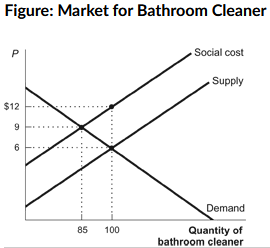
(Figure: Market for Bathroom Cleaner) Refer to the figure. The figure shows a market for cans of a bathroom cleaner that causes environmental damage, imposing costs on people other than the consumers and producers of the cleaner. What is the external cost of the bathroom cleaner?
a. $6
b. $9
c. $12
d. $3
a. $6
Market solutions to externality problems work when:
I. property rights are easily identifiable.
II. transaction costs are relatively low.
III. the market quantity is above the efficient quantity.
a. I only
b. I and II only
c. II and III only
d. I, II, and III
b. I and II only
The oil industry is an increasing cost industry because:
a. expanding output requires firms to use more expensive production methods to find and extract oil from less desirable locations.
b. people buy more oil at lower prices.
c. because oil is a necessity good.
d. All of these statements are correct.
a. expanding output requires firms to use more expensive production methods to find and extract oil from less desirable locations.
Marginal cost is:
a. the change in total cost from producing one more unit of output.
b. total cost divided by the change in total output.
c. the change in total output divided by the change in total cost.
d. average cost times output.
a. the change in total cost from producing one more unit of output.
An industry is said to be perfectly competitive when:
a. demand in the industry is high.
b. each firm has virtually no influence over the price of its product.
c. there are many buyers and sellers, and each is large relative tot he total market.
d. supply in the industry is highly elastic.
b. each firm has virtually no influence over the price of its product.
If price is less than average cost,:
a. the firm may still make profits as long as marginal cost is low.
b. the firm’s maximum profit is a loss.
c. there is no profit-maximizing rate of output.
d. marginal cost must be high.
b. the firm’s maximum profit is a loss.
To maximize profits, a firm in a highly competitive industry should set its price:
a. higher than the market price.
b. lower than the market price.
c. at the market price.
d. it depends: sometimes at the market price but sometimes higher or lower.
c. at the market price.
Profit is defined as:
a. net revenue minus depreciation.
b. average revenue minus average total cost.
c. marginal revenue minus marginal cost.
d. total revenue minus total cost.
d. total revenue minus total cost.
Price times quantity minus total cost equals:
a. total revenue
b. fixed costs.
c. marginal revenue.
d. profit.
d. profit.
In Texas, what does the term nodding donkey mean?
a. a donkey that is well-fed
b. an oil pump
c. a ranger
d. a cowboy
b. an oil pump
In an increasing cost industry,:
a. costs rise as industry output increases.
b. costs rise as industry output decreases.
c. the long-run supply curve is flat.
d. all firms will earn normal profits in the long run.
a. costs rise as industry output increases.
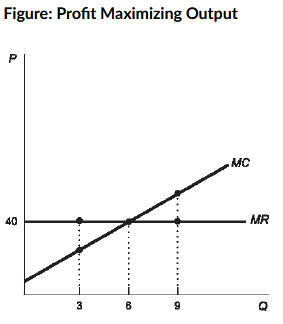
Use the figure. The profit-maximizing output for this firm is:
a. 40.
b. 3.
c. 6.
d. 9.
c. 6.
The power to raise price above marginal cost without fear that other firms will enter the market is:
a. market power.
b. firm power.
c. marginal power.
d. cost power.
a. market power.
An example of a monopoly would be:
a. a gasoline service station in Los Angeles.
b. a sole provider of electrical power in a city.
c. a grocery store in Chicago.
d. Walmart.
b. a sole provider of electrical power in a city.
A firm would prefer that its product demand curve is:
a. perfectly elastic.
b. elastic.
c. inelastic.
d. horizontal.
c. inelastic.

Under Michael Kremer’s patent-buyout proposal, the government would buy the rights to the firm in this figure’s patent for at least:
a. $30.
b. $40.
c. $10.
d. $50.
d. $50.
Which of the following is NOT a source of monopoly power?
a. laws preventing entry of competitors
b. economies of scale
c. innovation
d. inelastic demand for the product
d. inelastic demand for the product
A monopoly is a firm:
a. that is exempt from patent protection.
b. that sets price above marginal cost without concern that other firms will enter the industry.
c. without market power.
d. that sets price higher than or equal to marginal cost.
b. that sets price above marginal cost without concern that other firms will enter the industry.

In this figure, the monopolist’s marginal revenue curve is:
a. also the demand curve.
b. MR1.
c. MR2.
d. MR3.
c. MR2.
Generating electricity:
a. no longer requires a natural monopoly, but the transmission and distribution of electricity remains a natural monopoly.
b. requires a natural monopoly, along with the transmission and distribution of electricity.
c. requires a natural monopoly but not the transmission and distribution of electricity.
d. and the transmission and distribution of electricity are no longer natural monopolies.
a. no longer requires a natural monopoly, but the transmission and distribution of electricity remains a natural monopoly.
What is the profit maximization condition for a monopolist?
a. MR > MC
b. MR = MC
c. AR = MC
d. AR = D
b. MR = MC
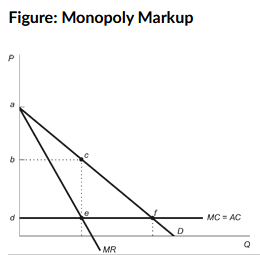
(Figure: Monopoly Markup) Refer to the figure. Consumer surplus under monopoly is represented by:
a. triangle abc
b. traingle cef.
c. square bcde.
d. triangle adf.
a. triangle abc
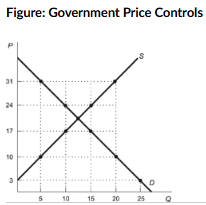
(Figure: Government Price Controls) Refer to the figure. If the government sets the price ceiling at $31, there will be:
a. a shortage of 15 units.
b. a surplus of 15 units.
c. a supply of 20 units.
d. no effect on the market.
d. no effect on the market.
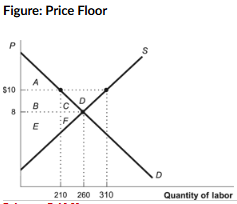
(Figure: Price Floor) Refer to the figure. What are the lost gains from trade as a result of the imposition of the price floor?
a. Areas (B + C)
b. Area D
c. Areas (C + F)
d. Areas (B + E)
c. Areas (C + F)
Price ceilings create five important effects:
a. shortages, reductions in product quality, wasteful lineups, a loss from gains to trade, and a misallocation of resources.
b. surpluses, increases in product quality, search costs, gains from trade, and resource attrition.
c. excess demand, long lines, poor service, efficiency, and arbitrage.
d. shortages, reduced time costs, low vacancy rates, blat, and deadweight loss.
a. shortages, reductions in product quality, wasteful lineups, a loss from gains to trade, and a misallocation of resources.
Deadweight loss is:
a. necessary to ensure that resources are channeled to their highest-valued use.
b. the loss to the economy from firms going out of business due to competition.
c. usually offset by deadweight gains.
d. the total of lost consumer and producer surplus when not all mutually profitable gains from trade are exploited.
d. the total of lost consumer and producer surplus when not all mutually profitable gains from trade are exploited.
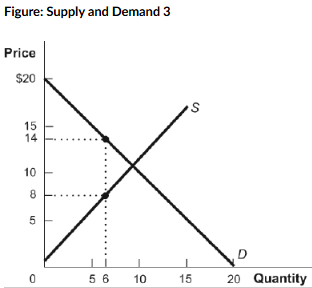
(Figure: Supply and Demand 3) Refer to the figure. If the government sets a price ceiling at $8 in this figure, it will create a deadweight loss of:
a. $6.
b. $36.
c. $9.
d. $24.
c. $9.
The Federal minimum wage causes unemployment MOSTLY among:
a. middle-class workers.
b. young unskilled workers.
c. college graduates.
d. highly skilled workers.
b. young unskilled workers.